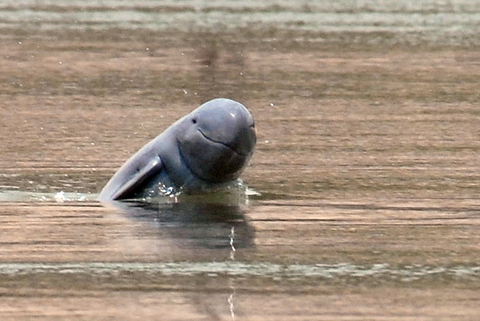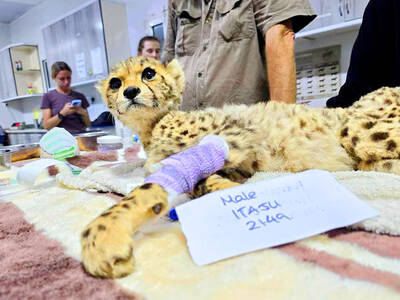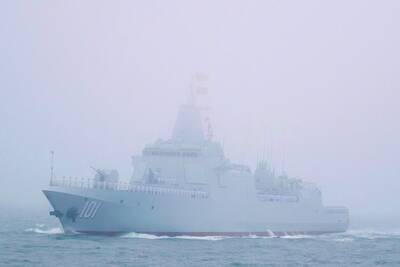Pollution in Southeast Asia’s Mekong River has pushed freshwater dolphins in Cambodia and Laos to the brink of extinction, an international conservation group said yesterday.
The World Wide Fund For Nature (WWF) said only 64 to 76 Irrawaddy dolphins remain in the Mekong after toxic levels of pesticides, mercury and other pollutants were found in more than 50 calves who have died since 2003.
“These pollutants are widely distributed in the environment and so the source of this pollution may involve several countries through which the Mekong River flows,” WWF veterinary surgeon Verne Dove said in a press statement.

PHOTO: AFP
The organization said it was investigating how environmental contaminants got into the Mekong, which flows through Cambodia, Laos, Myanmar, Thailand, Vietnam and the southern Chinese province of Yunnan.
The WWF said it suspected that high levels of mercury found in some dead dolphins came from gold mining activities.
It added that Irrawaddy dolphins in Cambodia and Laos urgently needed a health program to counter the effects of pollution on their immune systems.
Inbreeding among the small population could have also contributed to weakened immune systems of the young dead dolphins, all of whom were under two weeks old.
“The Mekong River dolphins are isolated from other members of their species and they need our help,” WWF Cambodia country director Seng Teak said, adding that the mammals “can show remarkable resilience” if their habitat is protected.
The Mekong River Irrawaddy dolphin, which inhabits a 190km stretch in Cambodia and Laos, has been listed as critically endangered since 2004, the WWF said.
Thousands of Irrawaddy dolphins once swam in the Mekong. Although regarded as sacred in Cambodia and Laos, their numbers were cut by illegal fishing nets and Cambodia’s drawn-out civil conflict, in which dolphin blubber was used to lubricate machine parts and fuel lamps.
The Cambodian government, however, has been promoting dolphin-watching to attract ecotourism and cracked down on the use of illegal nets that entangled them.
It was hoped that banning fishing nets in dolphins’ protected areas would raise their number to 170 within the next few years.
The Mekong is one of only five freshwater habitats in the world for the Irrawaddy dolphin, and Cambodia was thought to support its largest remaining population.
With their pale grey skin and blunt beaks, Irrawaddy dolphins resemble porpoises more than their sea-going cousins, and congregate in a handful of the Mekong’s natural deep-water pools.

ELECTION DISTRACTION? When attention shifted away from the fight against the militants to politics, losses and setbacks in the battlefield increased, an analyst said Recent clashes in Somalia’s semi-autonomous Jubaland region are alarming experts, exposing cracks in the country’s federal system and creating an opening for militant group al-Shabaab to gain ground. Following years of conflict, Somalia is a loose federation of five semi-autonomous member states — Puntland, Jubaland, Galmudug, Hirshabelle and South West — that maintain often fractious relations with the central government in the capital, Mogadishu. However, ahead of elections next year, Somalia has sought to assert control over its member states, which security analysts said has created gaps for al-Shabaab infiltration. Last week, two Somalian soldiers were killed in clashes between pro-government forces and

Ten cheetah cubs held in captivity since birth and destined for international wildlife trade markets have been rescued in Somaliland, a breakaway region of Somalia. They were all in stable condition despite all of them having been undernourished and limping due to being tied in captivity for months, said Laurie Marker, founder of the Cheetah Conservation Fund, which is caring for the cubs. One eight-month-old cub was unable to walk after been tied up for six months, while a five-month-old was “very malnourished [a bag of bones], with sores all over her body and full of botfly maggots which are under the

BRUSHED OFF: An ambassador to Australia previously said that Beijing does not see a reason to apologize for its naval exercises and military maneuvers in international areas China set off alarm bells in New Zealand when it dispatched powerful warships on unprecedented missions in the South Pacific without explanation, military documents showed. Beijing has spent years expanding its reach in the southern Pacific Ocean, courting island nations with new hospitals, freshly paved roads and generous offers of climate aid. However, these diplomatic efforts have increasingly been accompanied by more overt displays of military power. Three Chinese warships sailed the Tasman Sea between Australia and New Zealand in February, the first time such a task group had been sighted in those waters. “We have never seen vessels with this capability

‘NO INTEGRITY’: The chief judge expressed concern over how the sentence would be perceived given that military detention is believed to be easier than civilian prison A military court yesterday sentenced a New Zealand soldier to two years’ detention for attempting to spy for a foreign power. The soldier, whose name has been suppressed, admitted to attempted espionage, accessing a computer system for a dishonest purpose and knowingly possessing an objectionable publication. He was ordered into military detention at Burnham Military Camp near Christchurch and would be dismissed from the New Zealand Defence Force at the end of his sentence. His admission and its acceptance by the court marked the first spying conviction in New Zealand’s history. The soldier would be paid at half his previous rate until his dismissal